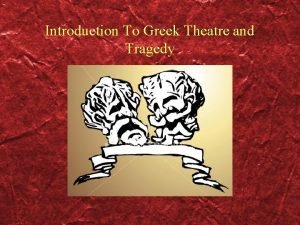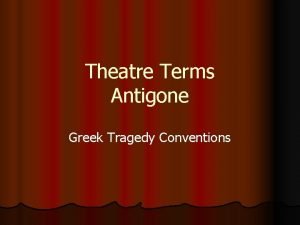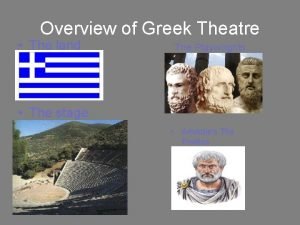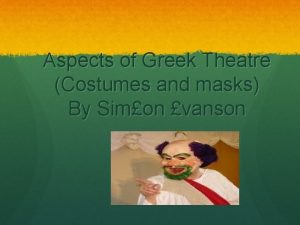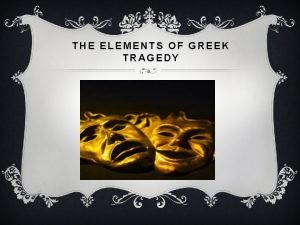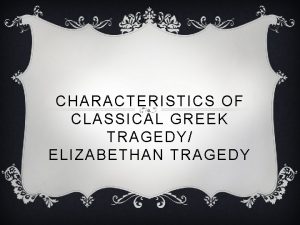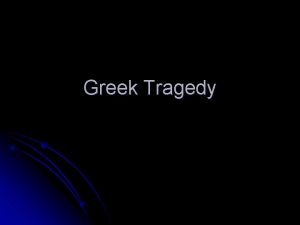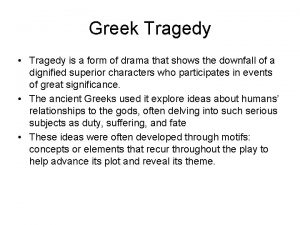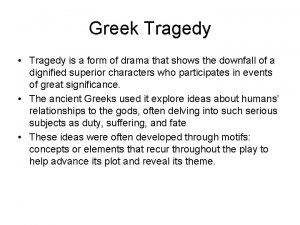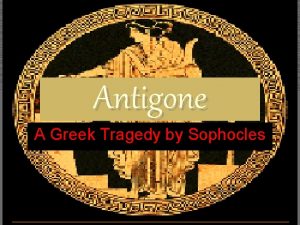Introduction to Greek Tragedy Its all Greek to















- Slides: 15

Introduction to Greek Tragedy “It’s all Greek to me…”

Background of Greek Tragedy l Origins Tragedy is thought to have developed from the ancient choral lyric which was sung by a male chorus in honor of Dionysus, god of wine, at his annual festivals. l The word “tragedy” comes from the Greek word “tragoidia” meaning “goat song. ” At these festivals the Greeks sacrificed a goat on the altar to Dionysus while singing the choral lyrics. l

l The lyric expanded from myths about Dionysus to stories from the whole legendary tradition. l The father of drama was said by the Greeks to have been Thespis. In 534 B. C. Thespis put on the first tragedy at the Festival of Dionysus in Athens.

l Plot of a Greek Tragedy l The stories used in tragedy were taken almost exclusively from mythology. These ancient myths and heroic legends were important to the Greeks, for they recorded what was thought to be the collective social, political, and religious history of the people and included many profound tales about the problems of human life and the nature of the gods.

l The custom requiring the use of these mythological stories in tragedy satisfied an essential requirement of the religious function of drama, for it enabled the poets to deal with subjects of great moral dignity and emotional significance.

l The audience then learned from tragedy what personal motives and outside forces had driven the characters to act as they did. Because poets used plots familiar to their audience, they would have opportunities to use irony and subtle (or not so subtle) allusions.

Who wrote Oedipus Rex? l Sophocles (496 B. C. – 406 B. C. ) His life spanned the rise and decline of the Athenian Empire, in which he was a playwright, government official, and warrior. l He preferred plays that dealt with the struggle of a strong individual against fate, portraying people as they should be. l The most memorable feature of Sophocles’ drama is his cast of vivid, dynamic characters. l

Greek Theatre l Performances were held in daylight in enormous, open-air arenas. A typical theatre was built on a hillside, giving the seating area a natural rise so thousands of spectators could clearly view the action. l The Actors l In the vast outdoor theatre, actors had to make themselves appear larger than life.

l Actors, cont. Each actor wore a mask of linen, cork, or wood, on which was painted an exaggerated expression. For example, a sad face for a troubled king, or a woman’s face to distinguish that the character was a woman since all actors were male. Funnel-shaped mouth openings helped actors project their voices. l Costumes were used to identify a specific type of character. These came in different colors to represent different characters. For example, to represent royalty, Greek actors wore tunics with sleeves and actors playing gods and goddesses usually had an identifying symbol. l

Structure of a Tragedy l Greek tragedies were performed without intermissions or breaks. Prologue – the opening scene, in which the background of the story is established, usually by a single actor l Parados – the entrance of the chorus, usually chanting a lyric which bears some relation to the main theme of the play l Episode – the counterpart of the modern act or scene, in which the plot is developed through action and dialogue between the actors, with the chorus sometimes playing a minor role. l

Structure of a Tragedy, Cont. l l Stasimon – the choral ode. A stasimon comes at the end of each episode so that the tragedy is a measured alternation between these two elements. Exodus – the final action after the last stasimon, ended by the ceremonial exit of all the players Strophe – stanza that chorus sings as they move from right to left across the stage Antistrophe – countermovement; stanza that chorus sings as they move from left to right across the stage

Define Tragedy l A tragedy is an imitation of an action that is serious, has magnitude, and is complete in itself. The incidents in the plot arouse pity and fear on the part of the audience so the end of the tragedy brings about a catharsis, an outlet or purging of emotions aroused in the play. The audience then leaves theatre cleansed and uplifted.

Tragic Hero l Since the aim of a tragedy is to arouse pity and fear through an alteration in the status of the central character, the tragic hero must be: A figure with whom the audience can identify so his fate can trigger the emotions of pity and fear on the part of the audience l True to life and consistent l Highly renowned and prosperous, but not preeminently virtuous and just l Possesses a flaw in his character that inevitably causes his downfall; this flaw is not a vice but a weakness of character l

Tragic Flaw l l The tragic hero possesses a tragic flaw so he will not be a completely admirable man, and thus a realistic character. The tragic flaw is Hubris which means overwhelming pride in oneself. Because he is so proud of himself, the tragic hero makes a mistake, which is called Ate. This mistake leads to his downfall or retribution or punishment, Nemesis.

The Legend and the Play l As with any Greek tragedy, Oedipus Rex (the King), is based on a legend. The task of the Greek playwright is to give the “continuing story” of the legend. l So listen closely and you will hear the Legend of Oedipus. (Introduction p. XLXLII)
 Origin of greek drama
Origin of greek drama Shakespeare comedy vs tragedy
Shakespeare comedy vs tragedy Characteristics of a shakespearean tragedy
Characteristics of a shakespearean tragedy Introduction to greek tragedy
Introduction to greek tragedy Theatron greek theatre definition
Theatron greek theatre definition Draw three noncollinear points j k and l
Draw three noncollinear points j k and l Greek theatre conventions
Greek theatre conventions Sophocles greek tragedy
Sophocles greek tragedy Greek theatre stage
Greek theatre stage Costumes in greek theatre
Costumes in greek theatre Elements of a greek tragedy
Elements of a greek tragedy Structure of tragedy
Structure of tragedy Youtube greek tragedy
Youtube greek tragedy Ancient greek theatre masks
Ancient greek theatre masks Narrative monologue
Narrative monologue Greek tragedy notes
Greek tragedy notes




